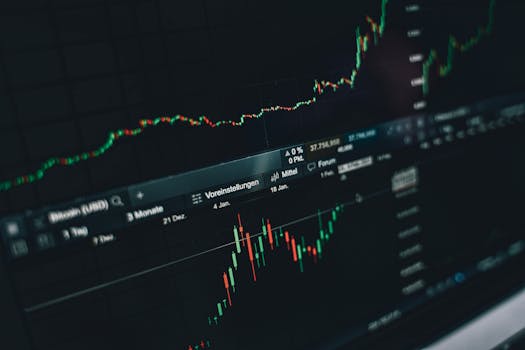Are you constantly checking the latest Bitcoin price charts, wondering what’s driving those dramatic swings? You’re not alone. For many, the daily fluctuations of Bitcoin’s value feel like a mystery, a game of chance dictated by tweets and headlines. But if you’re looking to truly understand the forces at play, it’s crucial to look beyond the surface. The reality is, the bitcoin price is shaped by a complex interplay of technological advancements, global economic trends, and the ever-evolving landscape of digital asset adoption.
It’s easy to get caught up in the frenzy, but a deeper dive reveals a more nuanced picture. Let’s explore the fundamental drivers that influence Bitcoin’s value, moving past the noise to gain a clearer perspective.
The Pillars of Bitcoin’s Value Proposition
At its core, Bitcoin’s value stems from its inherent properties and the problems it aims to solve. Understanding these foundational elements is key to grasping its price potential.
Scarcity and Predictability: Bitcoin operates on a fixed supply cap of 21 million coins. This digital scarcity, akin to precious metals, is programmed and immutable. The predictable issuance schedule, with halvings that reduce new supply every four years, creates a disinflationary model. This inherent scarcity is a significant psychological and economic factor for investors seeking a hedge against traditional fiat currency devaluation.
Decentralization and Censorship Resistance: Unlike traditional financial systems, Bitcoin is not controlled by any single entity, government, or bank. This decentralized nature means transactions can occur peer-to-peer, globally, without intermediaries and with a high degree of resistance to censorship. For many, this represents a fundamental shift in financial control and a compelling reason to hold Bitcoin.
Network Effects: As more individuals and institutions adopt Bitcoin, its utility and value increase. This is the classic network effect: the more people use a system, the more valuable it becomes for everyone involved. Greater adoption leads to increased liquidity, more merchant acceptance, and a stronger overall ecosystem, which in turn can positively influence the bitcoin price.
Macroeconomic Winds: The Global Influence
Bitcoin, despite its digital origins, is increasingly tethered to the broader global economic climate. Understanding these macro forces is paramount for any serious investor.
Inflation and Monetary Policy: In times of rising inflation and concerns about the devaluation of fiat currencies, Bitcoin is often seen as a potential store of value or a hedge. When central banks engage in quantitative easing or print more money, the appeal of a scarce, decentralized asset like Bitcoin can surge. This has been a significant narrative driving its price in recent years.
Interest Rates and Risk Appetite: Global interest rate policies play a crucial role. When interest rates are low, investors often seek higher returns in riskier assets, including cryptocurrencies. Conversely, rising interest rates can make safer investments more attractive, potentially drawing capital away from Bitcoin and other digital assets, impacting its price.
Geopolitical Stability: Unforeseen global events, from wars to political instability, can also influence investor sentiment. In times of uncertainty, capital can flow into assets perceived as safe havens, and Bitcoin, with its global accessibility and independence from single nation-states, can sometimes fit this bill for a segment of investors.
Adoption Trends: From Niche to Mainstream?
The ongoing journey of Bitcoin adoption, from a fringe technology to a more recognized asset class, has a direct correlation with its price.
Institutional Investment: The entry of institutional investors – hedge funds, asset managers, and corporations – has been a game-changer. Their significant capital inflows can create substantial demand and lend credibility to Bitcoin as an asset class. When major financial players announce Bitcoin holdings or investment products, it often sparks positive price momentum.
Retail Investor Interest: While institutional money is impactful, the collective interest of millions of retail investors also contributes significantly. Increased accessibility through user-friendly exchanges and growing awareness have brought more individuals into the Bitcoin market, driving demand.
Technological Developments and Infrastructure: Ongoing developments within the Bitcoin ecosystem itself, such as improvements in scalability (like the Lightning Network) and enhanced security protocols, can bolster confidence and utility. A more robust and user-friendly infrastructure makes Bitcoin more practical for everyday use and investment, indirectly supporting its bitcoin price.
Navigating Volatility: A Pragmatic Approach
It’s impossible to discuss Bitcoin without acknowledging its notorious volatility. While this can be daunting, it’s also an inherent characteristic that savvy investors learn to navigate.
The Psychology of the Market: Fear of missing out (FOMO) and panic selling are powerful psychological forces that can exacerbate price swings. Understanding these emotional undercurrents is as important as understanding the economic fundamentals.
Long-Term Perspective: Many proponents of Bitcoin advocate for a long-term investment horizon. They believe that the fundamental value proposition and adoption trends will ultimately outweigh short-term price volatility. This approach often involves dollar-cost averaging (DCA) to mitigate the risk of buying at market peaks.
Due Diligence is Key: Before making any investment decisions, thorough research is essential. Understand your risk tolerance, the specific factors influencing the market at any given time, and the long-term potential of the asset. Relying solely on speculative hype or chasing headlines is rarely a winning strategy.
Final Thoughts: The Evolving Narrative of Bitcoin Price
The journey of the bitcoin price is far from over. It’s a story still being written, influenced by technological innovation, global economic shifts, and the growing acceptance of digital assets. Moving beyond the sensational headlines and understanding the underlying drivers—scarcity, decentralization, network effects, macroeconomic forces, and adoption trends—provides a much more informed perspective. It allows us to see Bitcoin not just as a speculative gamble, but as a nascent technology and asset class with unique properties and potential.
Given its decentralized nature and fixed supply, how do you see Bitcoin’s role evolving in a world increasingly concerned with inflation and financial sovereignty?

